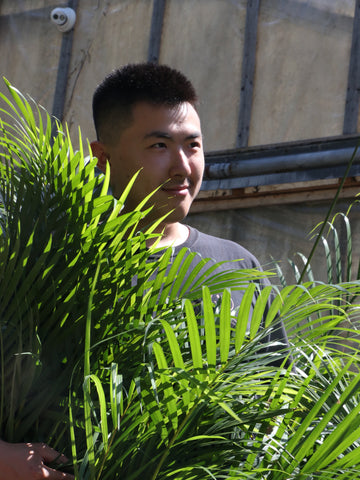
ARECA PALMS
Ahh we love areca palms here, they’re just SO FLUFFY
Scientifically known as the Dypsis lutescens, the Areca Palm also goes by a few other names; including the butterfly cane, golden cane, or yellow palm. They get the names ‘Golden Cane’ and ‘Yellow Palm’ not because of their leaf color, but due to the yellowish color of the base. This is one of the best ways to identify if a palm is really an areca palm tree! With all the nearly identical different palm tree varieties, from a majesty palm, to a kentia palm, to a bamboo palm, to a cat palm you’ll need all the tips you can get! The areca, like all indoor palm plants, are so popular due to their tropical vibes and tall/bushy nature, reaching heights up to 6 - 8 ft tall! This makes them great as ‘privacy plants’ (as I like to call them), blocking windows and giving you more privacy in your all-windows apartment or home. (cause god do architects nowadays love windows lol)
Now onto the good stuff…
---------------------------------------
How To Care For An Indoor Areca Palm
Before getting into all of the details you should know that arecas are not the most forgiving plants, meaning they require more attention than say a snake plant that you can forget about for a few weeks. If you did that to an areca chances are you will soon have a dead areca. But here’s how to make sure that doesn’t ever happen!
---------------------------------------
WATERING
Always remember when it comes to watering (with any plant) to consistently check the top layer of soil (inches dependent on pot size), by using a moisture meter or your own finger, and water only when needed (when the soil is dry). The areca palm prefers slightly moist soil in the spring and summer months and for the soil to get a little more dry in the fall and winter months.

---------------------------------------
LIGHT
The areca palm light requirements are pretty straightforward - they like indirect bright light, nothing more and not too much less or the leaves will start yellowing/browning. They are very specific when it comes to the amount of sunlight they get, so try to place them near a south or west-facing window! If you don't have either of these windows think of indirect bright light being a spot where it is bright enough to read a book with natural light only!
---------------------------------------
TEMP/HUMIDITY
Like most houseplants the areca prefers the temperature to be anywhere between 65 - 75° F, as long as the temperature is steady in that range, the areca will be fine. When it comes to humidity, they need lots of it. Originating in the tropical madagascar, they long for this hot and humid environment! In order to mimic this environment in your home you can use a pebble tray underneath the plant, group your plants together, or purchase a humidifier!
---------------------------------------
FERTILIZER
Once a month, in the summer months, mix a liquid houseplant/palm fertilizer into your water (diluted to the strength on the instructions) and feed those hungry suckers! The areca palms are heavy feeders, so they will really appreciate the extra boost! Be sure you are only fertilizing once a month because these plants are sensitive to build up of salts in the soil.
---------------------------------------
SOIL/POT
The soil of an areca needs to be loose and porous in order to have excellent drainage as their roots are very sensitive to moisture levels. As stated before, the areca prefers slightly moist soil, but is prone to being overwatered if the soil doesn’t drain well. This can lead to a build up of moisture and the proliferation of fungus/root rot. The areca is one of those plants that doesn’t store much nutrients in the stems, relying heavily on its roots, so if it gets root rot, it is 9/10 times going to perish. In order to prevent this the soil should have a good mix of 1 part perlite, 1 part pine bark, 1 part coarse potting soil and some peat moss!
Be sure not to repot the areca too often as it prefers a more cramped space for its roots! It should be repotted about every 2 to 3 years, or when the roots are peaking out of the bottom drainage hole.
---------------------------------------
If you enjoyed this article and want to know more about plants, or read more specific articles, such as The Top 5 Terrarium Plants or How To Turn Your Home Into A Desert Vista, click here!
If you have any questions, book a meeting with our plant expert here!
Questions or comments? Leave them down below!


